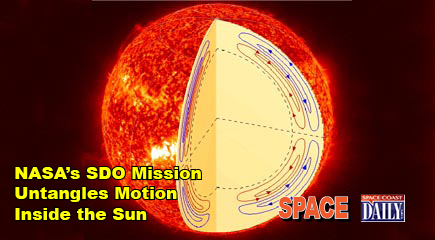NASA’s SDO Mission Untangles Motion Inside the Sun
By NASA.gov // July 27, 2014
UNDERSTANDING HOW THE 'DYNAMO' WORKS
NASA.gov – Using an instrument on NASA’s Solar Dynamics Observatory, called the Helioseismic and Magnetic Imager, or HMI, scientists have overturned previous notions of how the sun’s writhing insides move from equator to pole and back again, a key part of understanding how the dynamo works.

Using SDO, scientists see a performance of explosions and fountains on the solar surface. Shots of solar material leap into the air. Dark blemishes called sunspots grow, combine and disappear as they travel across the sun’s face.
Bright loops of charged particles – captured by magnetic fields dancing around the sun – hover in the atmosphere. This dynamic display is all powered by a complex, ever-changing magnetic current inside the sun known as the dynamo.
This magnetic system flips approximately every 11 years, with magnetic north and magnetic south switching poles. This process is an integral part of the sun’s progression toward a pinnacle of solar activity, known as solar maximum.
DOUBLE LAYER OF CIRCULATION
The team’s results show that, instead of a simple cycle of flow moving toward the poles near the sun’s surface and then back to the equator, the material inside the sun shows a double layer of circulation, with two such cycles on top of each other. The results appear online in the Astrophysical Journal Letter.

“For decades people have known that the solar cycle depends on the poleward flow or material, changing the magnetic fields from one cycle to the next,” said Philip Scherrer, principal investigator for HMI at Stanford University in Stanford, Calif.
“We mapped out what we believed to be the flow pattern in the 1990s, but the results didn’t quite make sense.”
Since the mid-1990s researchers have been observing movement inside the sun using a technique called helioseismology. The technique makes use of the fact that waves course across the sun, back and forth, oscillating with an approximately five minute period.
Since the mid-1990s researchers have been observing movement inside the sun using a technique called helioseismology. The technique makes use of the fact that waves course across the sun, back and forth, oscillating with an approximately five minute period.
Such waves are similar to the seismic waves that spread out under the ground during an earthquake. By monitoring the oscillations seen at the surface of the sun, scientists can gather information about the material through which the waves traveled, including what the material is made of and how fast and in what direction it is moving.












